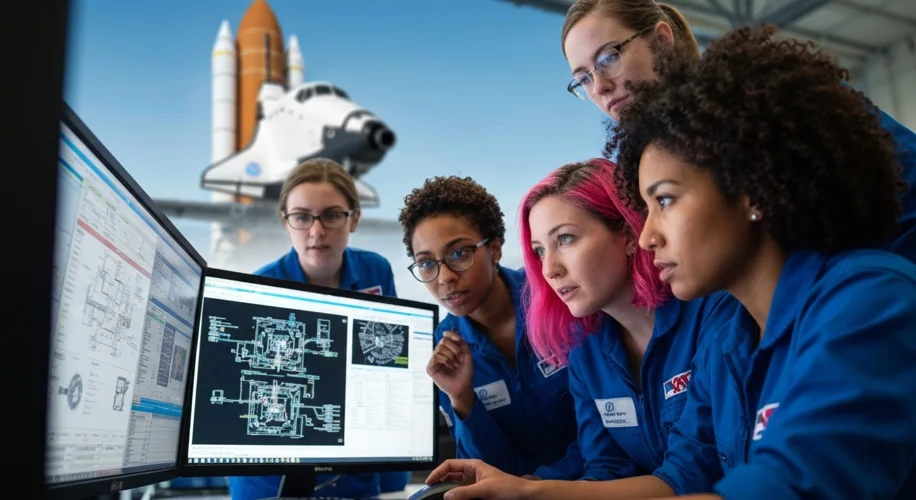The roar of the Space Shuttle engines was more than just the sound of America reaching for the stars; it was the overture to a new era for women within NASA. For decades, the hallowed halls of space exploration had been largely the domain of men. Early astronauts were exclusively white males, their heroic journeys broadcast to a nation hungry for triumph. But as NASA geared up for the Space Shuttle program, a revolutionary fleet of reusable spacecraft set to revolutionize spaceflight from 1981 to 2011, the agency began to quietly, yet profoundly, open its doors wider than ever before.
The Mercury 13, a group of thirteen American women who passed the same rigorous physical and psychological tests as their male counterparts in the early 1960s, were a stark reminder of the talent pool that had been systematically excluded. Despite their qualifications, they were denied the opportunity to become NASA astronauts, a painful testament to the deeply ingrained sexism of the time. Their story, largely suppressed for years, became a rallying cry for many advocating for gender equality in STEM fields.
The Space Shuttle program, however, represented a shift. It wasn’t an overnight revolution, but a gradual, deliberate expansion. The program’s very nature demanded a broader range of skills and a larger crew complement compared to the earlier Gemini and Apollo missions. This created new opportunities, not just for astronauts, but for engineers, scientists, technicians, and mission controllers – roles that were increasingly becoming accessible to women.

One of the most visible breakthroughs came with the selection of Sally Ride in 1978, becoming the first American woman in space aboard the Space Shuttle Challenger in 1983. Her journey was a monumental event, watched by millions. Ride wasn’t just an astronaut; she was a symbol. Her presence in orbit shattered the pervasive image of the lone male astronaut, demonstrating that women were not only capable but essential to the future of space exploration.
But Sally Ride was not an anomaly; she was a harbinger of change. The Space Shuttle program continued to select and train female astronauts, including Guion Bluford (the first African American in space in 1983, though a man, his selection was part of a broader diversity push), Judith Resnik (who tragically died aboard the Challenger), and Mae Jemison (the first African American woman in space in 1992 aboard Endeavour). Each woman who flew aboard the Shuttle, whether as a pilot, mission specialist, or payload specialist, chipped away at the existing stereotypes and expanded the perception of who could be an astronaut.
Beyond the cockpit and the crew quarters, the Shuttle era saw a significant increase in women taking on critical roles on the ground. Women moved into roles as flight directors, navigators, engineers designing the complex systems of the Shuttle, and scientists analyzing the data gathered from orbit. These were not ceremonial positions; they were positions of immense responsibility, requiring sharp intellect and technical prowess.
Think about the intricate dance required to bring the Shuttle back to Earth, landing like a giant glider. This complex maneuver was overseen by mission control teams where women were increasingly represented in key decision-making roles. They were the voices guiding the astronauts, the minds calculating trajectories, and the eyes monitoring every critical system. Their contributions were vital to the success and safety of every mission.
The legacy of the Space Shuttle program extends far beyond its operational years, which concluded in 2011. It fundamentally altered the landscape of opportunities for women at NASA and, by extension, in the broader scientific and technological communities. The visible successes and the steady integration of women into all facets of the program provided powerful role models for a new generation. Young girls who watched these missions on television saw not just rockets and astronauts, but possibilities for themselves. They saw that the dream of space was a dream within their reach.
The struggle for equality is ongoing, and the path has not always been smooth. Tragic events like the Challenger and Columbia disasters served as somber reminders of the inherent risks of spaceflight, regardless of gender. Yet, the increased representation and the critical roles played by women during the Shuttle era laid an indelible foundation. The program proved, unequivocally, that talent and dedication know no gender. It wasn’t just about conquering the final frontier; it was about ensuring that humanity’s greatest endeavors were powered by the full spectrum of its brightest minds. The echoes of the Space Shuttle’s engines still reverberate, a testament to the day women truly began to claim their place among the stars.

